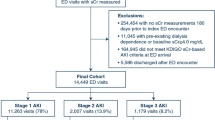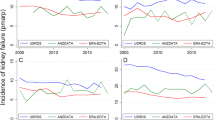Abstract
Background
Posterior urethral valves (PUV) is the most common cause of obstructive uropathy in boys; approximately 15% develop kidney failure by early adulthood. However, rates of kidney function decline are poorly defined in PUV children and adults, as is the impact of potentially modifiable chronic kidney disease (CKD) progression risk factors.
Methods
We conducted a retrospective review of all PUV patients followed at our institution from 1995 to 2018. Inclusion criteria were estimated glomerular filtration rate (eGFR) > 20 ml/min/1.73 m2 after 1 year of age, no dialysis or kidney transplant history, and ≥ 2 yearly serum creatinine values after age 1 year. eGFRs were calculated using creatinine-based estimating formulas for children (CKID U25) or adults (CKD-EPI). The primary outcome was annualized change in eGFR, assessed with linear mixed effects models. We also examined the association of acute kidney injury (AKI), proteinuria, hypertension (HTN), and recurrent febrile urinary tract infections (UTIs) with eGFR decline.
Results
Fifty-two PUV patients met the inclusion criteria. Median (interquartile range) eGFR decline was 2.6 (2.1, 3.1) ml/min/1.73 m2/year. Children (n = 35) and adults (n = 17) demonstrated progressive decline. Proteinuria and recurrent UTIs were significantly associated with faster progression; AKI and HTN were also associated but did not reach significance.
Conclusion
PUV patients show progressive loss of kidney function well into adulthood. Proteinuria and recurrent UTIs are associated with faster progression, suggesting potential modifiable risk factors. This is the first study to report annualized eGFR decline rates in PUV patients, which could help inform the design of clinical trials of CKD therapies.
Graphical abstract

A higher resolution version of the Graphical abstract is available as Supplementary information

Similar content being viewed by others
Data availability
The data that support the findings of this study may be available from the authors but restrictions apply to the availability of these data, which are the property of Cleveland Clinic and are not publicly available. Deidentified data, however, may be available from the authors upon reasonable request and with permission of Cleveland Clinic’s Law Department after an appropriate data use agreement has been fully executed.
References
Thakkar D, Deshpande AV, Kennedy SE (2014) Epidemiology and demography of recently diagnosed cases of posterior urethral valves. Pediatr Res 76:560–563
Hodges SJ, Patel B, McLorie G, Atala A (2009) Posterior urethral valves. Sci World J 9:1119–1126
Sarhan O, El-Dahshan K, Sarhan M (2010) Prognostic value of serum creatinine levels in children with posterior urethral valves treated by primary valve ablation. J Pediatr Urol 6:11–14
Coquillette M, Lee RS, Pagni SE, Cataltepe S, Stein DR (2020) Renal outcomes of neonates with early presentation of posterior urethral valves: a 10-year single center experience. J Perinatol 40:112–117
Kwong JC, Khondker A, Kim JK, Chua M, Keefe DT, Dos Santos J, Skreta M, Erdman L, D’Souza N, Selman AF, Weaver J, Weiss DA, Long C, Tasian G, Teoh CW, Rickard M, Lorenzo AJ (2022) Posterior urethral valves outcomes prediction (PUVOP): a machine learning tool to predict clinically relevant outcomes in boys with posterior urethral valves. Pediatr Nephrol 37:1067–1074
Ruiz-Ortega M, Rayego-Mateos S, Lamas S, Ortiz A, Rodrigues-Diez RR (2020) Targeting the progression of chronic kidney disease. Nat Rev Nephrol 16:269–288
Katsoufis CP (2020) Clinical predictors of chronic kidney disease in congenital lower urinary tract obstruction. Pediatr Nephrol 35:1193–1201
Bilgutay AN, Roth DR, Gonzales ET Jr, Janzen N, Zhang W, Koh CJ, Gargollo P, Seth A (2016) Posterior urethral valves: risk factors for progression to renal failure. J Pediatr Urol 12 :179.e1–7
Ansari MS, Gulia A, Srivastava A, Kapoor R (2010) Risk factors for progression to end-stage renal disease in children with posterior urethral valves. J Pediatr Urol 6:261–264
Coleman R, King T, Nicoara CD, Bader M, McCarthy L, Chandran H, Parashar K (2015) Combined creatinine velocity and nadir creatinine: a reliable predictor of renal outcome in neonatally diagnosed posterior urethral valves. J Pediatr Urol 11:214.e1–3
Furth SL, Pierce C, Hui WF, White CA, Wong CS, Schaefer F, Wuhl E, Abraham AG, Warady BA, Chronic Kidney Disease in Children (CKiD); Effect of strict blood pressure control and ACE inhibition on the progression of CRF in pediatric patients (ESCAPE) study investigators (2018) estimating time to ESRD in children with CKD. Am J Kidney Dis 71:783–792
Sebastiao YV, Cooper JN, Becknell B, Ching CB, McLeod DJ (2021) Prediction of kidney failure in children with chronic kidney disease and obstructive uropathy. Pediatr Nephrol 36:111–118
Heikkila J, Holmberg C, Kyllonen L, Rintala R, Taskinen S (2011) Long-term risk of end stage renal disease in patients with posterior urethral valves. J Urol 186:2392–2396
Sanna-Cherchi S, Ravani P, Corbani V, Parodi S, Haupt R, Piaggio G, Innocenti ML, Somenzi D, Trivelli A, Caridi G, Izzi C, Scolari F, Mattioli G, Allegri L, Ghiggeri GM (2009) Renal outcome in patients with congenital anomalies of the kidney and urinary tract. Kidney Int 76:528–533
Cetin B, Donmez MI, Erdem S, Ziylan O, Oktar T (2021) Renal, bladder and sexual outcomes in adult men with history of posterior urethral valves treated in childhood. Urology 153:301–306
Levey AS, Coresh J (2012) Chronic kidney disease. Lancet 379:165–180
Melhem N, Rasmussen P, Joyce T, Clothier J, Reid CJD, Booth C, Sinha MD (2021) Acute kidney injury in children with chronic kidney disease is associated with faster decline in kidney function. Pediatr Nephrol 36:1279–1288
Dionne JM, Jiang S, Ng DK, Flynn JT, Mitsnefes MM, Furth SL, Warady BA, Samuels JA; CKiD Study Group (2021) Mean arterial pressure and chronic kidney disease progression in the CKiD cohort. Hypertension 78:65–73
Fathallah-Shaykh SA, Flynn JT, Pierce CB, Abraham AG, Blydt-Hansen TD, Massengill SF, Moxey-Mims MM, Warady BA, Furth SL, Wong CS (2015) Progression of pediatric CKD of nonglomerular origin in the CKiD cohort. Clin J Am Soc Nephrol 10:571–577
Kula AJ, Prince DK, Flynn JT, Bansal N (2021) BP in young adults with CKD and associations with cardiovascular events and decline in kidney function. J Am Soc Nephrol 32:1200–1209
Kumar N, Yadav P, Jain S, Kumar GA, Kaushik VN, Ansari MS (2021) Evaluation of polyuria and polydipsia along with other established prognostic factors in posterior urethral valves for progression to kidney failure: experience from a developing country. Pediatr Nephrol 36:1817–1824
Pierce CB, Munoz A, Ng DK, Warady BA, Furth SL, Schwartz GJ (2021) Age- and sex-dependent clinical equations to estimate glomerular filtration rates in children and young adults with chronic kidney disease. Kidney Int 99:948–956
Schwartz GJ, Munoz A, Schneider MF, Mak RH, Kaskel F, Warady BA, Furth SL (2009) New equations to estimate GFR in children with CKD. J Am Soc Nephrol 20:629–637
Levey AS, Bosch JP, Lewis JB, Greene T, Rogers N, Roth D (1999) A more accurate method to estimate glomerular filtration rate from serum creatinine: a new prediction equation. Modification of Diet in Renal Disease Study Group. Ann Intern Med 130:461–470
Flynn JT, Kaelber DC, Baker-Smith CM, Blowey D, Carroll AE, Daniels SR, de Ferranti SD, Dionne JM, Falkner B, Flinn SK, Gidding SS, Goodwin C, Leu MG, Powers ME, Rea C, Samuels J, Simasek M, Thaker VV, Urbina EM; Subcommittee on screening and management of high blood pressure in children (2017) Clinical practice guideline for screening and management of high blood pressure in children and adolescents. Pediatrics 140:e20171904
Kellum JA, Lameire N; KDIGO AKI Guideline Work Group (2013) Diagnosis, evaluation, and management of acute kidney injury: a KDIGO summary (Part 1). Crit Care 17:204
Sutherland SM, Byrnes JJ, Kothari M, Longhurst CA, Dutta S, Garcia P, Goldstein SL (2015) AKI in hospitalized children: comparing the pRIFLE, AKIN, and KDIGO definitions. Clin J Am Soc Nephrol 10:554–561
Ardissino G, Testa S, Dacco V, Paglialonga F, Vigano S, Felice-Civitillo C, Battaglino F, Bettinelli A, Bordugo A, Cecchetti V, De Pascale S, La Manna A, Li Volti S, Maringhini S, Montini G, Pennesi M, Peratoner L (2012) Puberty is associated with increased deterioration of renal function in patients with CKD: data from the ItalKid Project. Arch Dis Child 97:885–888
Warady BA, Abraham AG, Schwartz GJ, Wong CS, Munoz A, Betoko A, Mitsnefes M, Kaskel F, Greenbaum LA, Mak RH, Flynn J, Moxey-Mims MM, Furth S (2015) Predictors of rapid progression of glomerular and nonglomerular kidney disease in children and adolescents: the chronic kidney disease in children (CKiD) cohort. Am J Kidney Dis 65:878–888
Pohl M, Mentzel HJ, Vogt S, Walther M, Ronnefarth G, John U (2012) Risk factors for renal insufficiency in children with urethral valves. Pediatr Nephrol 27:443–450
Vasconcelos MA, Simoes ESAC, Dias CS, Gomes IR, Carvalho RA, Figueiredo SV, Dumont TR, Oliveira MCL, Pinheiro SV, Mak RH, Oliveira EA (2019) Posterior urethral valves: comparison of clinical outcomes between postnatal and antenatal cohorts. J Pediatr Urol 15:167.e161-167.e8
McLeod DJ, Ching CB, Sebastiao YV, Greenberg JH, Furth SL, McHugh KM, Becknell B (2019) Common clinical markers predict end-stage renal disease in children with obstructive uropathy. Pediatr Nephrol 34:443–448
Waas T, Schulz A, Lotz J, Rossmann H, Pfeiffer N, Beutel ME, Schmidtmann I, Munzel T, Wild PS, Lackner KJ (2021) Distribution of estimated glomerular filtration rate and determinants of its age dependent loss in a German population-based study. Sci Rep 11:10165
Wu CQ, Blum ES, Patil D, Shin HS, Smith EA (2022) Predicting childhood chronic kidney disease severity in infants with posterior urethral valve: a critical analysis of creatinine values in the first year of life. Pediatr Nephrol 37:1339–1345
Vasconcelos MA, e Silva ACS, Gomes IR, Carvalho RA, Pinheiro SV, Colosimo EA, Yorgin P, Mak RH, Oliveira EA (2019) A clinical predictive model of chronic kidney disease in children with posterior urethral valves. Pediatr Nephrol 34:283–294
Coleman R, King T, Nicoara CD, Bader M, McCarthy L, Chandran H, Parashar K (2015) Nadir creatinine in posterior urethral valves: how high is low enough? J Pediatr Urol 11(356):e351-355
Funding
Research reported in this publication was supported in part by the National Institute of Diabetes and Digestive and Kidney Diseases of the National Institutes of Health under Award Number T35DK111373.
Author information
Authors and Affiliations
Corresponding author
Ethics declarations
Ethics approval
The retrospective study was approved by the Cleveland Clinic Institutional Review Board (IRB).
Competing interests
The authors declare no competing interests.
Disclaimer
The content is solely the responsibility of the authors and does not necessarily represent the official views of the National Institutes of Health.
Additional information
Publisher's note
Springer Nature remains neutral with regard to jurisdictional claims in published maps and institutional affiliations.
Victoria W. Huang and Mohga Behairy are co-first authors. Katherine M. Dell and Audrey Rhee are co-senior authors.
Supplementary Information
Below is the link to the electronic supplementary material.
Rights and permissions
Springer Nature or its licensor (e.g. a society or other partner) holds exclusive rights to this article under a publishing agreement with the author(s) or other rightsholder(s); author self-archiving of the accepted manuscript version of this article is solely governed by the terms of such publishing agreement and applicable law.
About this article
Cite this article
Huang, V.W., Behairy, M., Abelson, B. et al. Kidney disease progression in pediatric and adult posterior urethral valves (PUV) patients. Pediatr Nephrol 39, 829–835 (2024). https://doi.org/10.1007/s00467-023-06128-0
Received:
Revised:
Accepted:
Published:
Issue Date:
DOI: https://doi.org/10.1007/s00467-023-06128-0




